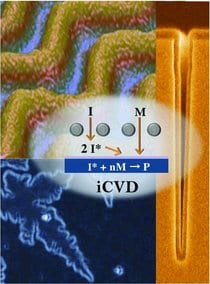 Chemical vapour deposition (CVD) is a powerful tool in surface science, finding particular use in developing thin films for semiconductors. CVD techniques in a variety of formats, which take advantage of different aspects of organic chemistry. In their article in Macromolecular Chemistry and Physics—which forms a part of the “Best of Macros” series—Karen Gleason and co-workers focus on a particular process called initiator CVD (iCVD). This particular version of CVD holds advantages over its counterpart methods, and allows modification of physical surface properties and creation of new interfaces.
Chemical vapour deposition (CVD) is a powerful tool in surface science, finding particular use in developing thin films for semiconductors. CVD techniques in a variety of formats, which take advantage of different aspects of organic chemistry. In their article in Macromolecular Chemistry and Physics—which forms a part of the “Best of Macros” series—Karen Gleason and co-workers focus on a particular process called initiator CVD (iCVD). This particular version of CVD holds advantages over its counterpart methods, and allows modification of physical surface properties and creation of new interfaces.
The iCVD technique is different from the other techniques as it uses an initiator to start the polymerisation process. Once introduced into the process, the initiator thermally decomposes to form radicals, which are adsorbed onto the surface and thus initiate free-radical polymerisation. The low energy cost of iCVD holds advantages over other CVD methods, as the process can be conducted at a low temperature.
A variant of iCVD—called oxidative CVD (oCVD)—uses an oxidant molecule as both an initiator and as a dopant, allowing step-growth polymerisation of conducting and semiconducting polymers. The electrical properties of the films developed by oCVD allow for their use in developing photovoltaic arrays, so this technique holds huge benefits in the micro-electrics industry.
Using functional surfaces in biotechnology is an interesting field of research. In particular, surfaces that can reversibly switch their properties in response to an external stimulus hold great interest to scientists in this field. The phenomenon of dynamic remodelling is frequently seen in nature, and being able to mimic this process using synthetic surfaces is important in biomedicine. Over other techniques, iCVD is particularly useful in this application as it allows close control of film thickness and conformality, retention of chemical function, and short deposition times.
Finally, creating surfaces with selective permeability has applications in biotechnology, microfluidics, and electronics and energy. iCVD can be used to develop such surfaces, onto which an inorganic layer can be deposited—a procedure that is extremely important in the electronics industry for creating “barrier” layers to protect the functional layer from external degradation by, for example, oxygen or water vapour. Selectivity to specific gases is also important in medical applications such as artificial lung devices, and free-standing surfaces created by iCVD have been demonstrated to exhibit such selectivity.
The authors conclude by remarking that continuing development of CVD methods is essential to ensure that they remain viable techniques in an industrial environment. As a versatile and rapidly developing process for developing thin films, iCVD looks to have an important future role in the next generation of functional surface science.
This article is part of the special Best of Macros 2013 issue and is now free to read at http://www.best-of-macros.de!

















